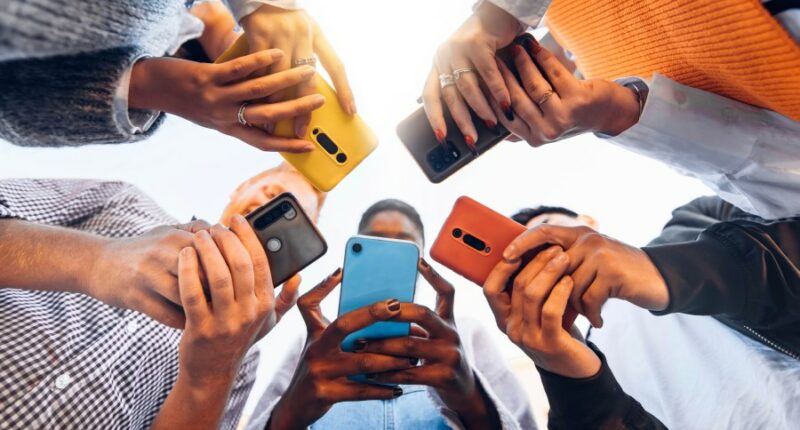Share this @internewscast.com

(NewsNation) — For many in 2025, as screen time increases, productivity decreases.
Smartphones have become an integral part of daily life for many people worldwide, yet this dependence can lead to problematic habits and even addiction. Social media, which has made it easier for people to stay connected, is significantly contributing to this addiction and causing mental health issues.
Numerous tools and technologies have been developed to help both parents with children who are addicted to their phones and individuals who want to control their own screen time. But which solutions are the most effective, and how exactly do they function?
- Tampa police in standoff with armed man in vehicle
Apps
Even though both iOS and Android devices include screen-limiting features, these are often criticized for being too easy to bypass and not very effective in preventing excessive use. To overcome these limitations, many people are turning to third-party applications.
According to a report from CNET, some of the best apps to limit screen time are:
Opal
Opal is one of the leading apps designed to help manage phone usage, offering various features to help reduce unnecessary screen time. Users can establish daily usage limits, set recurring restrictions, and allocate specific times for app use. Additionally, the app offers comprehensive analytics to track phone usage patterns.
Users can earn digital rewards for successfully cutting down on screen time, and they can also engage in friendly competitions with others, making the process more engaging and game-like.
Opal has saved users over 220,000,000 hours and counting, the company boasts on its website.
Opal offers a free version and a $100 a year full version.
The app is exclusively available on iOS.
one sec
One sec takes a different approach by tackling the issue directly. According to its website, it requires users to complete an exercise before accessing a designated app, thus promoting mindful usage.
Our brains are wired to crave instant gratification, and the app creates a system that forces the user to reflect on their unhealthy phone behavior in real time. The app separates itself by forcing users to justify their phone usage.
“Contrary to other apps with similar objectives, one sec is not a temporary solution,” according to its website.
One sec offers a free version and a full version for a one-time payment of $20.
The app is available on both iOS and Android.
Forest
The Forest app is much simpler than the apps previously mentioned. Its strength lies in providing a visual representation of progress made in reducing screen time by allowing users to create and protect a virtual forest.
The app allows users to set a timer for the amount of time they want to be distraction-free. As users stay on the app, a plant will grow, and eventually a forest will form. If users leave the app, the plant will stop growing and wither away.
In addition to helping users reduce unwanted screen time, once enough progress is made in the virtual forest, the company will donate to the nonprofit Trees for the Future.
Forest requires a one-time $4 purchase.
The app is available on both iOS and Android.
Devices
While apps can be useful, some need a physical barrier to effectively limit screen time. Here are a couple of good options:
Brick
Brick is a device that users tap with their iPhone to disable certain pre-selected apps for indefinite periods of time.
When users are ready to unblock the apps, they can simply tap the device again, and their phone resets to allow all of their apps to work again.
Users are given 5 emergency unlocks in case early access to the restricted apps is needed.
Brick retails for $53.10 and comes with access to a companion app.
The product is exclusively compatible with iOS devices.
Mindset Phone Lockbox
Designed to completely eliminate phone access for certain amounts of time, the Mindset Phone Lockbox has three distinct modes.
The lockbox feature allows users to temporarily lock their phones and unlock them manually when needed.
The standard setting allows users to set a timer between 1 minute and 30 days. An override code is available if users need to get into the phone before the timer is up.
Fortress mode enables users to set a timer without an override option, requiring them to wait for the set time to expire before accessing their device.
The lockbox retails for $30 and is compatible with almost every phone.
Flip phones
Sometimes, the simplest solutions are the best.
Recently, there has been a growing trend of people trading in their smartphones for flip phones.
Gen Z is leading the charge as many yearn for a digital detox. One increasingly popular trend on social media is “flip phone summer.”
“Flip phone summer is a test of human will,” one girl told NBC4 Washington.
Some popular flip phone models include:
TCL Flip Go
The TCL Flip Go is a standard flip phone that provides users with simple call and text functions along with limited internet browsing capability.
The phone retails for $96 from T-Mobile.
Nokia 2780 Flip
The Nokia 2780 Flip is a step above the TCL Flip Go. It has call, text and internet access along with a functioning app store.
The phone can also last for up to 18 days on a single charge.
The phone retails for $89.99 from Best Buy.













